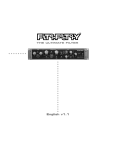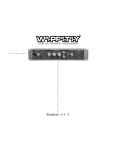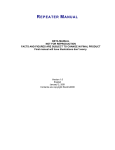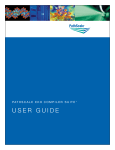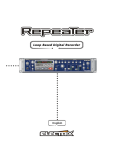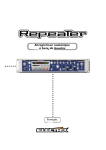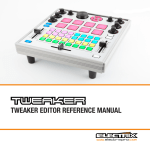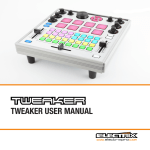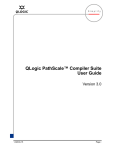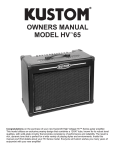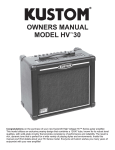Download Electrix FilterQueen Owner`s manual
Transcript
English V1.0 Stereo Vintage Filter Owner’s Manual CAUTION RISK OF ELECTRIC SHOCK DO NOT OPEN A T T E N T I O N : RISQUE DE CHOC ELECTRIQUE - NE PAS OUVRIR W A R N I N G : TO REDUCE THE RISK OF FIRE OR ELECTRIC SHOCK DO NOT EXPOSE THIS EQUIPMENT TO RAIN OR MOISTURE The lightning flash with arrowhead symbol, within an equilateral triangle, is intended to alert the user to the presence of uninsulated ‘dangerous voltage’ within the product’s enclosure that may be of sufficient magnitude to constitute a risk of electric shock to persons. The exclamation point within an equilateral triangle is intended to alert the user to the presence of important operating and maintenance (sevicing) instructions in the literature accompanying the product. INSTRUCTIONS PERTAINING TO A RISK OF FIRE, ELECTRIC SHOCK, OR INJURY TO PERSON IMPORTANT SAFETY INSTRUCTIONS READ AND SAVE THESE INSTRUCTIONS This product may be equipped with a polarized line plug ( one blade wider than the other). This is a safety feature. If you are unable to insert the plug into the outlet, contact an electrician to replace your obsolete outlet, Do not defeat the safety purpose of the plug. For the USA For Canada For Polarized Line Plug: Caution: TO PREVENT ELECTRIC SHOCK, MATCH WIDE BLADE OF PLUG TO WIDE SLOT, FULLY INSERT. Attention: POUR …VITER LES CHOCS …LECTRIQUES, INTRODUIRE LA LAME LA PLUS LARGE DE LA FICHE DANS LA BORNE CORRESPONDANTE DE LA PRISE ET POUSSER JASQUí AU FOND. For the U.K. IMPORTANT: THE WIRES IN THIS MAINS LEAD ARE COLOURED IN ACCORDANCE WITH THE FOLLOWING CODE: BLUE: NEUTRAL BROWN: LIVE As the colours of the wires in the mains lead of this apparatus may not correspond with the coloured markings identifying the terminals in your plug, proceed as follows. The wire which is coloured BLUE must be connected to the terminal which is marked with the letter N or coloured BLACK. The wire which is coloured BROWN must be connected to the terminal which is marked with the letter L or coloured RED. Under no circumstances must either of the above wires be connected to the earth terminal of the three pin plug. Double Insulation: When servicing use only identical replacement parts. WARNING - When using electric products, basic precautions should always be taken, including the following: 1. Read all the instructions before using the product. 2. Do not use this product near water - for example near a bathtub, washbowl, kitchen sink, in a wet basement, or near a swimming pool, or the like. 3. This product should be used only with a cart or stand that is recommended by the manufacturer. 4. This product, either alone or in combination with an amplifier and headphones or speakers, may be capable of producing sound levels that could cause permanent hearing loss. Do not operate for long period of time at high volumeor at an uncomfortable level. If you experience any hearing loss or ringing in the ears, consult an audiologist. 5. This product should be located with sufficient air space for proper ventilation. 6. The product should be located away from heat sources such as radiators, heat registers, or other products (including amplifiers) that produce heat. 7. Clean only with a damp cloth. Before cleaning the unit, turn off the power and unplug the power cord from the outlet. 8. The power supply cord of the product should be unplugged from the wall outlet during lightning storms or when left unused for a long periods of time. 9. Use only with attachments/accessories specified by the manufacturer. 10. The product should be serviced by qualified service personnel when: A. The power supply cord or the plug has been damaged; or B. Objects have fallen, or liquids has been spilled into the product; or C. The product has been exposed to rain; or D. The product does not appear to be operate normally or exhibits a marked change in performance; or E. The product has been dropped, or the enclosure damaged. 11. Do not attempt to service the product beyond what has been described in the user maintenance instructions. All other servicing should be referred to qualified service personnel. Table of Contents Introduction . . . . . . . . . . . . . . . . . . . . . . . . . . . . . . . . . . . . . . . . . . . . . . . . . . .5 Quick Start . . . . . . . . . . . . . . . . . . . . . . . . . . . . . . . . . . . . . . . . . . . . . . . . . . . .6 What to Connect Where . . . . . . . . . . . . . . . . . . . . . . . . . . . . . . . . . . . . . . . .6 A First Look at the Controls . . . . . . . . . . . . . . . . . . . . . . . . . . . . . . . . . . . . . .7 Understanding the Filter Queen . . . . . . . . . . . . . . . . . . . . . . . . . . . . . . . . . . . . .8 Front Panel . . . . . . . . . . . . . . . . . . . . . . . . . . . . . . . . . . . . . . . . . . . . . . . . . .8 Back Panel . . . . . . . . . . . . . . . . . . . . . . . . . . . . . . . . . . . . . . . . . . . . . . . . . .11 Performance Guide . . . . . . . . . . . . . . . . . . . . . . . . . . . . . . . . . . . . . . . . . . . . .12 Artist Applications . . . . . . . . . . . . . . . . . . . . . . . . . . . . . . . . . . . . . . . . . . . . . .15 Specifications . . . . . . . . . . . . . . . . . . . . . . . . . . . . . . . . . . . . . . . . . . . . . . . . .17 Saftey & Conformity . . . . . . . . . . . . . . . . . . . . . . . . . . . . . . . . . . . . . . . . . . . .18 Inventory INSPECTION: The uniquely styled Electrix carton should contain: • Electrix Filter Queen • Filter Queen User Manual • Rackmount kit (shipped attached to product) • Warranty Card • Power Transformer (as appropriate for your region) • Electrix Joiner Plate (joins two "Mods" together!) Note: If any of the above are missing, please inform your local Electrix distributor, agent or dealer immediately. English... 3 Settings Template Title: Session: Artist: Description: Date: Introduction Welcome to Electrix! We would like to thank you for purchasing Filter Queen, by far the best 'bang for the buck' in Analog High Order Filters. Filter Queen represents an entirely new concept in musical electronics, unique in both its ‘hands on’ ease of use and ‘retro-futuristic’ design. Filter Queen can directly process a wide range of input signal sources from vinyl to CDs, as well as synthesizers, samplers, guitars, or just about anything else in your rig. Filter Queen’s digitally controlled Analog filters are modeled after VCF’s (Voltage Controlled Filters) like those found in traditional Analog synthesizers. Use the Filter Queen to 'filter sweep' across the instruments in a mix, or choose a particular instrument or frequency range in the mix to 'highlight and tweak' or 'search and distort.' The Filter Queen will put realtime control of your sound back into your hands. A New Dimension in FX! Filter Queen is part of a new series of remix tools from Electrix called the ‘Mods.’ Like the Modular Synthesizers of the 60’s and 70’s, multiple ‘Electrix Mods’ can be racked together to create a ‘hands on’ effects monster. Filter Queen’s unique industrial design allows it to be used in a 10" rack mount or as a desktop tool. We’ve even included a joiner plate to connect two Mod products together to fit in a 19" rack. The ultra-smooth feel of the knobs and gold plated switch contacts put the 'Electrix Mods' processors in a class of their own. They are 'Effects Instruments' that have been designed to be 'played live' on stage and in the studio. Check out the shape! For maximum flexibility, connect Filter Queen to other members of the Electrix Mods family. For example, EQ Killer is a great sounding 'Band Kill' box. The EQ Killer allows you to cut or isolate the bass, mids, or highs in a track. For even more dramatic effects, isolated bands are sent to an effects loop - so while the unaffected bass keep pounding you can put effects on everything else in the mix - a new song with the flick of your wrist! Also, check out the Electrix MO-FX for distortion, flanging and delay, or the Electrix Warp Factory for vocal effects and vocoding. We want to know what YOU think about the future of Remix, and we would also like to hear what you can do with Electrix gear. Please send your DATs, CDs, MDs, vinyl or cassettes to us at the address on the back page of this manual. Want to find out more about the Mods or other Electrix products? Check out our Web site at: http://www.electrixpro.com. Again, thanks for purchasing Filter Queen. Now get ‘Hands On’ and get creative! English... 5 QUICK START • What to Connect to Where Here is the simplest way to pass audio signals through Filter Queen and create effects: Connect the Power Transformer here. Connect a Momentary footswitch to disengage the filter here. Select 2 pole stereo or 4-pole mono with this mode switch. Connect audio inputs here. Select phono or line input level. Use these line level outputs to connect to the mixer or power amplifier. QUICK START • A First Look at the Controls Frequency is the most playable filter control. Use the Frequency control for Filter sweeps, and to find frequency resonance that adds character to the music. The ENV Follower adjusts the filter frequency according to the dynamics of the input signal. 'Release' increases the decay rate of the ENV Follower. 'Depth' sets the amount the ENV Follower will effect the Filter Frequency. 'Band' limits the frequency range of the ENV Follower detector. Use this to focus the ENV follower in on a specific instrument. The 'Low Pass' filter type is the standard synthesizer setting. This setting rolls off the high frequencies when the frequency control is turned to the left. Resonance controls the level of the filter frequency. Set it between 5-6 for typical filter sweep sounds. Use the momentary button to play the effect. As you tap it, the effect will momentarily engage. When you engage the filter, the momentary button switches its function and mutes the effect. The LFO can automatically sweep the filter frequency. Choose from five waveforms and use the 'Depth' control to adjust the amount the LFO applied to the filter. 'Rate' controls the speed of the LFO. English... 7 Understanding the Filter Queen • Front Panel ENV Following Explained: The ENV Follower tracks the amplitude (volume) of the input to Filter Queen and opens up the Filter Frequency in scale with the dynamics. ENV Following will produce totally funked out sounds when the filter frequency control is set low and the ENV depth is set just right to track the dynamics of the music. are: All bands, High, Mid, Low, Low+High, Low+Mid, High+Mid. Note: Every time the Band button is pressed Filter Queen will cycle to the next combination. However, at any point in the cycle the Band button can be held down for 300ms and it will return directly to All bands. Filter Frequency: Sets the cutoff frequency of the stereo filENV Follower Depth: Sets the amount the input signal’s 'dynamic envelope' will affect the Filter frequency. Start around 5 with this control. 3-7 is the general range in which most instruments trigger the envelope follower properly. 7-10 is for lowlevel signals. ter. Use it in conjunction with the resonance control. The more resonance you use the more distinct any changes you make with frequency will be. The frequency tuning range of the filter covers a 12 octave range from 10 Hz to 20 kHz. Any 3rd party 1/4" TRS Expression Pedal, (such as a Roland EV-5) can control the filter frequency. (Great for guitar or bass.) ENV Follower Release: Turning the release knob slows down and smoothes out the ENV follower response. Use shorter release settings for more immediate response. This control can subtly change the percussive quality of your mix. ENV Follower Band Select: Selects between 7 combinations of the frequency bands the ENV follower can track. The ENV follower band select can be used to focus the ENV Follower in on a particular frequency band. For example the mid band will focus in on the snare drum and vocals, while the high band will pick up hihats and cymbals. The combinations are represented by 3 LED for High, Mid, and Low. The combinations Resonance: This controls the level of the peak at the resonant frequency of the filter, i.e. the frequency you dialed in with the frequency knob. The Filter Queen’s resonance control can be set to negative values by rotating the control all the way counter clockwise. In Low Pass, High Pass and Band Pass modes, negative resonance will simply smooth out the response of the filter, making it less distinct. In Notch Filter mode, negative feedback will increase the depth of the notch filter making it more pronounced. Understanding the Filter Queen • Front Panel Filter Type: This control selects the basic sound of the filter. The Band Pass Filter acts like Wah pedal and puts a peak Each filter type has a unique sound. You will find situations where each one offers you a unique effect on a given signal. in the middle of your signal. (See Fig. 2) This is great for highlighting certain frequency ranges or for creating a sweeping sound with the frequency knob. The Low Pass Filter is the most commonly used filter type. This is the kind of filter you will find on vintage synths and enveCutoff point lope followers. It is useful for controlling the amount -3 dB of harmonics or the 100 Hz brightness of a signal. As dB Sine wave you sweep the frequency 1,000 Hz Sine wave control, try adding some resonance to make the cutoff frequency more FREQUENCY audible. 0 -3 dB -10 dB -20 Bandwidth -30 -40 -50 0 10 20 30 50 70 100 200 300 500 700 1000 2,000 3,000 5,000 7,000 10,000 FREQUENCY -10 -20 -30 -40 -50 10 20 30 50 70 100 200 300 500 700 1000 2,000 3,000 5,000 7,000 10,000 The Notch Filter works the exact opposite of the Band Pass filter. Instead of a boost, it puts a notch in your signal, essentially killing a narrow frequency band. This effect often sounds like talking through a pipe. For a more dramatic -3 dB Notch Filter effect use turn the Resonance condB Bandwidth trol all the way counter clockwise into negative Resonance to increase the depth of the notch FREQUENCY and the distinctiveness of the effect. It will also create unique sweeping sounds, (that are similar to a phase shifter) when used in conjunction with the LFO. For best Notch result put the Resonance knob fully counter-clockwise. 0 -10 Cutoff point 0 The High Pass Filter will roll off the bass of your signal making things sound thinner as you turn the frequency control to the right. -3 dB -10 dB -20 -30 -40 -50 10 20 30 50 70 100 200 300 500 700 1000 FREQUENCY 2,000 3,000 5,000 7,000 10,000 -20 -30 -40 -50 10 20 30 50 70 100 200 300 500 700 1000 2,000 3,000 5,000 7,000 10,000 English... 9 Understanding the Filter Queen • Front Panel Filter Engage: This control toggles the filter on and off. When the filter is off the Filter queen circuit is bypassed. Whenever the Filter Queen is Engaged the LFO is automatically restarted. Use this feature to start long LFO sweeps on the downbeat by engaging the Filter Queen right on the top of the bar. Filter Momentary: This switch temporarily engages the stereo filter. Try using it to tap rhythmic patterns while adjusting the frequency knob. Effect Mix: Controls the Mix of the Filter in relation to your dry signal. 0% is all dry, or the same as bypassing the Filter Queen. 100% will be all Filter Queen and none of your dry signal. LFO Waveform: The LFO provides the following cyclic (or repetitive) waveforms: Sawtooth, Inverse Sawtooth, Triangle, Square Wave and Random. If you increase the LFO depth and turn the LFO speed up a bit you will be able to hear their effect on your frequency setting. The Square Waveform is great for gating effects, while the triangle is better for long, slow sweeps. LFO Depth: This controls the amount the LFO changes the filter frequency. LFO Speed: LFO Speed controls the period of the LFO waveforms by changing the frequency of the LFO. The LFO Frequency range covers 0.05 Hz to 30 Hz for subtle to extreme effects. In and Out Level LEDs: These LEDs help you set and monitor the optimal signal levels from your signal sources as well as the outputs of Filter Queen. The optimal setting occurs when the In and Out LEDs show mostly green with periodic peaks of red. . Understanding the Filter Queen • Back Panel Control Pedal Input: Plug a standard Expression pedal in here to control the Filter Frequency remotely. Use an expression pedal, like the Roland EV-5, that terminates with a 1/4"TRS connector. RCA Stereo Outputs: The RCA output level is nominally +4 dBu 1/4" Outputs: This output produces an unbalanced +4dBu signal. Footswitch: Use a standard momentary footswitch to turn Engage on and off. Filter Queen accepts normally open momentary footswitches. (In the near future an Electrix 3 button footswitch will be available that will add extra functionality to the Filter Queen. Stay tuned for more information….) 4 Pole Mono: The Filter Queen operates in a Stereo 2 Pole filter per channel mode, (unless you switch to 4 Pole mode). When in Four Pole mode, the Filter Queen switches into Mono operation by summing the left and right channels before the 4 pole filter. A two pole filter will give you a gentler response, in technical terms it is defined as a 12dB/octave filter. A 4 pole or 24dB/octave filter will give you a much steeper filter response that will sound more pronounced. 4 pole mono is especially appropriate for effecting electric guitar and bass. Phono/Line Switch: This switches the RCA inputs to accept phono or line level. RCA Stereo Inputs: When the Phono/Line switch is in the Line position, this input is optimized for a +4dBu input signal. When the Phono/Line switch is set to Phono, the RIAA phono pre-amp will accept a range of cartridge output levels. 1/4" Inputs: This input is optimized for +4 dBu input signal. Grounding Post: Connect the ground wire from your turntable here. Cable Strain Relief: The power supply cable can be looped around this to prevent stress on the power entry jack. English... 11 Performance Guide Set-up 1: Pre Mixer This is the most basic way to integrate the Filter Queen into any setup. In the studio this setup is a great way to warm up digital keyboards or give drum machines new life. This setup also has special advantages for live DJ's in that a turntable can be directly connected to the Filter Queen's built in phono pre-amp. With this setup the effected signal can be cued on the mixer while other sources are playing. Set-up 2: Mixer - Insert MAIN OUT L AUX SEND 1 AUX RET L INSERT 4 INSERT 3 INSERT 2 INSERT 1 MAIN OUT R AUX SEND 2 AUX RET R LINE IN 4 LINE IN 3 LINE IN 2 LINE IN 1 The Filter Queen can be inserted into a console's channel or bus insert just like any other outboard EQ or compressor. This setup makes for easy repatching and allows you to quickly audition the effect that Filter Queen will have on any number of sources. Performance Guide Set-up 3: Amp Effects Loop The Filter Queen can be inserted into a guitar amp or bass amp's effects loop. Use the 4 pole mono mode in this setup and experiment with Filter Queen's Effects Mix control to get the best balance between the wet, (effected) and dry signals. Set-up 4: Mixer with Aux Sends MAIN OUT L AUX SEND 1 AUX RET L INSERT 4 INSERT 3 INSERT 2 INSERT 1 MAIN OUT R AUX SEND 2 AUX RET R LINE IN 4 LINE IN 3 LINE IN 2 LINE IN 1 This setup requires a mixer with auxiliary (aux) sends and return capabilities. All sources are connected directly to the mixer channel inputs. Filter Queen is fed its signals from the mixer’s aux sends. This setup allows any or all of your sound sources to be processed through Filter Queen at any time. The mix control on Filter Queen should be set to 100% wet so that the dry source signal is only heard through the mixer. English... 13 Performance Guide Set-up 5: DJ - Post Mixer This is a simple setup for stereo processing of your entire mix. You’ll want to use this setup only after you have explored all the sonic possibilities of Filter Queen because cueing is not possible. Bringing in the effect gradually with Filter Queen’s mix control and doing any adjustments from there can minimize the cueing limitation. Artist Applications Phaser: Drum FX: That swooshy sound, that was initially made popular as a Fender Rhodes effect, is also available in the Filter Queen. This effect works especially on sounds with sustained portions such as voice, synth pads and of course, Fender Rhodes. You can use the Envelope Follower to create a 'WAKKA' sound that exactly follows the dynamics of rhythmic input. Here’s how it’s done: Frequency Knob: 20 Type: Notch Resonance Knob: 2.0 ENV Follower Depth: Off ENV Follower Release: 0 Waveform: Triangle LFO Depth: 10 LFO Speed: Experiment (slow is good, medium warble is nice too) Effect Mix: 100 % Frequency Knob: 115 Type: Low Pass Resonance Knob: 4 ENV Depth: 6 ENV Release: 35% Band: Low/Mid Effect Mix: To taste Playing with the ENV Follower Depth and Frequency knobs will customize the effect to your liking. Changing the Filter Type will emphasize different frequency bands. Note that when you try the Notch filter type setting, you’ll have to set the resonance to –2.5 and the frequency knob to around 640. English... 15 Artist Applications Guitar Amp Setup! - The Foot Wah: Bass Boost: Connect an expression pedal up to the Frequency Controller input. Now get ready for the most customizable wah one could conceive. Try different filter modes, and adjusting the resonance. Add a little envelope following for more interactive tones. This can create some stunning effect from subtle bass enhancement to 'boom car' euphoria. Use with caution as this setting can launch even the best subwoofer speaker cones clear across the room. (12V version to follow.) Frequency Knob: 115 Type: Band Pass Resonance Knob: 2.5 ENV Depth: 3.0 LFO Depth: Off Effect Mix: 100 Note: when using Filter Queen with a guitar or a bass amp, be sure to insert the Filter Queen into the amplifier’s Effects loop. This will give Filter queen the appropriate levels to function properly. It is recommended that Filter Queen not be connected between a guitar and an amplifier, it should always be connected to an amplifier via its effects loop. Frequency Knob: 20-40 Set it while the music is playing for dramatic FX Type: HPF Resonance Knob: 4 ENV Follower Depth: 1.5 ENV Follower Release: 30% ENV Band: Low LFO Depth: 0 Effect Mix: 100 % Set for the desired amount of bass boost. Specifications INPUT Connectors: Max Input Level: Impedance: 1/4” Line +18 dBu 77KΩ RCA (Phono) -20dBV 47KΩ RCA (Line) +18dBu 47KΩ 1/4” Line 1KΩ +18 dBu RCA 1KΩ +18dBu RCA 1KΩ +18 dBu 1/4” >90db <0.3% 10Hz-20.0kHz PHONO >75db <0.3% 10Hz-20.0kHz RCA >90db <0.3% 10Hz-20.0kHz OUTPUT OUTPUTS Connectors: Impedance: Max Output Level: PERFORMANCE Dynamic Range: THD: Frequency Response: POWER CONSUMPTION 16 watts USE ONLY WITH ELECTRIX POWER SUPPLY MODEL TFR0028 VOLTAGE 100 V 120 V 230 V 240 V FREQUENCY 50/60 Hz 60 Hz 50 Hz 50 Hz Actual measurements are subject to change English... 17 Saftey and Conformity This equipment has been tested and found to comply with the limits for a class A digital device, pursuant to part 15 of the FCC rules. These limits are designed to provide reasonable protection against harmful interference in a residential installation. Caution: You are cautioned that any change or modifications not expressly approved in this manual could void your warranty. For the customers in Canada: This equipment generates, uses and can radiate radio frequency energy and, if not installed and used in accordance with the instructions, may cause harmful interference to radio communications. However, there is no guarantee that interference will not occur in a particular installation. This Class B digital apparatus meets all requirements of the Canadian Interference-Causing Equipment Regulations. If this equipment does cause harmful interference to radio or television reception, which can be determined by turning the equipment on and off, the user is encouraged to try to correct the interference by one or more of the following measures: Certificate of Conformity • Reorient or relocate the receiving antenna. • Increase the separation between the equipment and the receiver. • Connect the equipment into an outlet on a circuit different from that to which the receiver is connected. • Consult a qualified dealer or an experienced radio / TV technician for help. The user may find the following booklet, prepared by the Federal Communications Commission, helpful: “How to identify and Resolve Radio/TV interference Problems.” This booklet is available from the US Government Printing Office, Washington, DC 20402, USA. Stock No. 004-000-0034-4. Cet appareil Numerique de la Classe B respecte toutes les exigences du Reglement sur le materiel brouilleur du Canada. Electrix, a div. of IVL Technologies Ltd., hereby declares on their own responsibility that the following product: Electrix Filter Queen that is covered by this certificate and marked CE-label conforms with the following standards: • EN 60065 Safety requirements for mains operated Electronic and related apparatus for household and similar general use • EN 55022: 1994 (Limits and Methods: ITE Disturbances) • EN 55082-1: 1997 (Generic Immunity: Residential) With reference to regulations in following directives: 72/23/EEC, 89/336/EEC as amended by directive 93/68/EEC Issued in Victoria, February 15, 2000 by Brian Gibson, Executive VicePresident, Research and Development



















